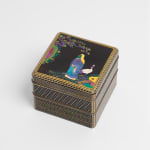A Somada Lacquer Tiered Incense Box (Jukogo), Meiji Period (Late 19th Century)
(2 1/2 x 2 1/2 x 2 1/8 in.)
Further images
The box with two tiers and flush-fitting cover intricately decorated overall with inlays of cut shell and gold and silver foils. The interiors with dense nashiji, the rims silver and inner rims in fundame.
This ancient and idyllic scene is rendered with an intricate use of aogai (lit. blue-green shell). Finely cut and shaped, these tiny pieces of shell were inlaid into a polished black lacquer ground to form highly precise geometric and pictorial designs. The marbled turban (yakogai – lit. night-shining shell) was selected for its varying blue, green, pink and violet colour. When turned in the light, the various elements of the design on the cover of the box change colour. The use of shell in this manner was employed particularly by craftsmen of the Somada school. The founder of the school, Somada Kiyosuke is alleged to have studied the technique from Chinese artisans residing in the port of Nagasaki in the early eighteenth century. (1)
1. Beatrix von Ragué, A History of Japanese Lacquerwork, (Toronto, 1976), p. 197.
Provenance
The Ankarcrona collection
Sten Ankarcrona (1861-1936) started collecting Japanese works of art as a young officer in the Swedish navy. On his first visit to Japan in the late 1880s he became fascinated by the intricacies of Japanese lacquer, making numerous purchases, and continued to add to his collection after his return to Europe. In 1923, by then an admiral, he went back to Japan at the request of the King of Sweden, at which time he made numerous more purchases. The collection was then further added to by the admiral's descendants throughout the 20th and early 21st centuries.
Publications
Eskenazi Ltd., Japanese Inro and Lacquer-ware from a Private Swedish Collection, (London, 1996), no. 69, p. 70-71.






